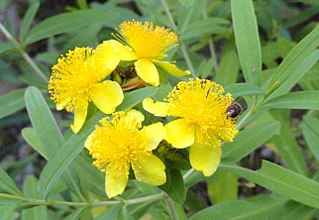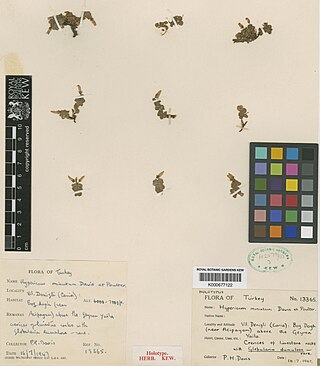
Hypericaceae is a plant family in the order Malpighiales, comprising six to nine genera and up to 700 species, and commonly known as the St. John's wort family. Members are found throughout the world apart from extremely cold or dry habitats. Hypericum and Triadenum occur in temperate regions but other genera are mostly tropical.

Triadenum, known as marsh St. John's worts, is a small genus of flowering plants in the family Hypericaceae. The genus is characterized by opposite, blunt-tipped leaves and pink flowers with 9 stamens. They are distributed in North America and eastern Asia.

Hypericum concinnum is a species of flowering plant known as gold-wire or goldwire. It is in the St. John's wort family, Hypericaceae. It is the only species in the section Hypericum sect. Concinna.

Hypericum balearicum is a species of flowering plant in the family Hypericaceae, native to Spain's Balearic Islands. It is the only species in the section Psorophytum.
Hypericum addingtonii is a shrubby species of flowering plant in the family Hypericaceae. It is native to China and was described by Norman Robson in 1985.
Hypericum xylosteifolium is a flowering plant in the St. John's wort family, Hypericaceae. It is the only species in Hypericum sect. Inodora.
Hypericum umbraculoides is a species of flowering plant, a deciduous shrub in the St. John's wort family, Hypericaceae. It is the sole species in the section Hypericum sect. Umbraculoides.
Hypericum pubescens is a perennial herb in the Hypericaceae family. It is in the section Adenosepalum.

Hypericum kalmianum, commonly called Kalm's St. Johns wort or Kalm's St. Johnswort, is a flowering plant in the St. John's wort family Hypericaceae. It is native to the Great Lakes region in the northern United States and southern Canada. Hypericum kalmianum was named after its discoverer, Swedish botanist Pehr Kalm (1715-1779).

Hypericum cerastioides is a species of perennial flowering plant in the St. John's wort family, Hypericaceae. It is the only species in the section Hypericum sect. Campylopus.

Hypericum reflexum is a species of plant in the St. Johns wort family, Hypericaceae, endemic to the Canary Islands. It is a small shrub up to 1 m in height with opposite, sessile leaves up to 25 mm (0.98 in) long and 12 mm (0.47 in) across. The flowerheads produce 5–40 bright yellow flowers with five petals each.

Hypericum japonicum, known as matted St. John's-wort, is an annual herbaceous flowering plant in the St. John's wort family Hypericaceae, in Hypericum sect. Trigynobrathys.
Hypericum assamicum is a species of flowering plant in the St. John's wort family, Hypericaceae. It is endemic to India. Hypericum assamicum is one of two species of Hypericum in the section Hypericum sect. Sampsonia.

Hypericum huber-morathii is a species of flowering plant in the St John's wort family Hypericaceae. It is a small perennial herb with few stems. It has narrow and brittle stems, thick leaves, flowers in clusters of varying numbers, small yellow petals, around twenty stamens, and three styles. H. huber-morathii is closely related to H. minutum and H. sechmenii, and also shares characteristics with H. lanuginosum. The plant is endemic to Turkey, and is found among limestone rocks in a limited region of southwestern Anatolia. Originally excluded from a comprehensive monograph of Hypericum, the species' placement within the genus is unclear. It has been placed in both section Adenosepalum and section Origanifolium.

Hypericum aucheri, also known as Koramanotu in Turkish, is a herbaceous perennial flowering plant in the St. John's wort family Hypericaceae.

Hypericum coris, the heath-leaved St. John's wort, also called yellow coris, is a species of flowering plant in the family Hypericaceae, and is the type species of sect. Coridium. It is a low shrub, and it is found in Switzerland and northwestern Italy. The species has been a popular garden plant since the 18th century, valued for its long flowering period and for how well it adapts to cultivation.
Hypericum antiquum is an extinct species of the genus Hypericum that was present during the Eocene epoch. The species' fossils are the oldest collected of Hypericum, and it is believed that the species is the common ancestor of the tribe Hypericeae. Fossil seeds have been found in Russia, and the predicted paleoregion of the species stretched across Eurasia. It is theorized that one factor leading to the species' extinction is a global cooling at the end of the Eocene that removed much of its habitat.

Hypericum minutum is a species of flowering plant in the St John's wort family Hypericaceae. It is a small perennial herb that grows in tufts. It has slender and brittle stems, flowers in clusters of one to three, yellow petals with black and amber glands, few stamens, and a seed capsule with narrow grooves. H. minutum is closely related to H. huber-morathii and H. sechmenii and resembles a smaller form of the latter plant. The plant is endemic to Turkey, and is found among limestone rocks in a limited region of southwestern Anatolia. Originally excluded from a comprehensive monograph of Hypericum, the species' placement within the genus is unclear. It has been placed in both section Adenosepalum and section Origanifolium.
Hypericum confertum is a species of flowering plant of the St. John's Wort family (Hypericaceae) which is native from Turkey to Lebanon and on the island of Cyprus.












